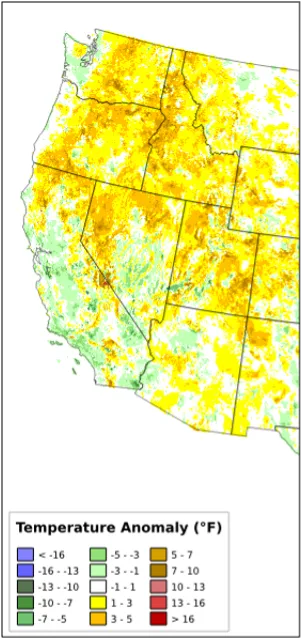Three to four weeks ago I sent out a blog on the potential for blanking due to cool nighttime temperatures during booting. Low nighttime temperatures are a concern because blanking (floret sterility) can occur during meiosis (pollen formation) when they drop below 58 oF. Blanking can cause reduced yields. The cooler it is and the more nights during this period with low temperatures have an increasingly negative effect on yield. I have wrote about this more extensively in my previous blog.
This sensitive stage of pollen formation occurs during booting, which is roughly between 7 days after panicle initiation (PI) and 7 days before flowering. While it depends on variety, this stage will begin around 55 to 60 days after planting. This year in California, the bulk of rice acreage was planted in mid-May. For this rice, pollen formation begin in mid-July and will continue to end of July.
Below are two figures developed in PRISM (https://prism.oregonstate.edu/). You can see in the left panel that in the Sacramento Valley, nighttime temperatures for July average between 55 and 63 oF depending on where in the valley. It is cooler as you move further south. On the right side you can see the variation from the average. In the north of the valley, July nighttime temperatures were normal. However, in the southern half of the valley, nighttime temperatures were 1-3 oF below normal. Given already cooler nighttime temperatures in the southern part of the valley, this likely resulted in temperatures well below the critical limit and may have caused blanking.
The highest risk from blanking would be in fields:
- in the southern part of the valley
- that were planted with M209 or M211
- where booting occurred during the critically low temperature periods
- where field water height was not raised during booting.
Right now, the critical stage has passed for most rice grown in California. As I write, most fields are around heading or well past. If your field was damaged due to blanking, you may start to notice it during later grain fill, where you will see unfilled (blank) spiklets.
Image  | Image  |
Figure 1. Left: Average low nighttime temperatures for July. Right: July 2025 nighttime variation from average.
